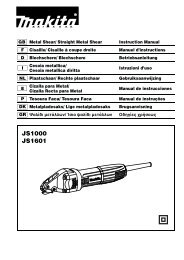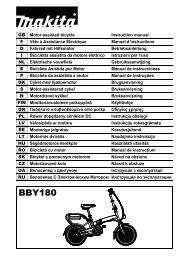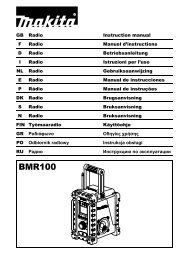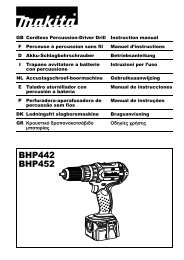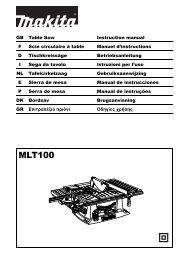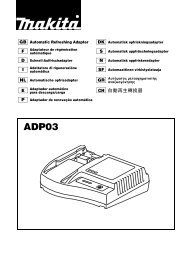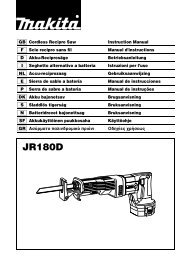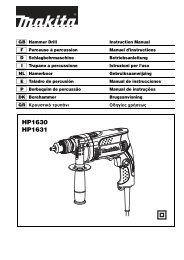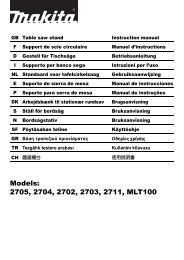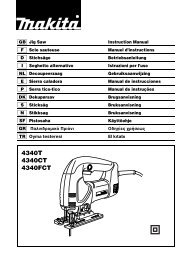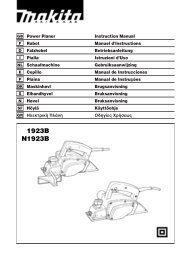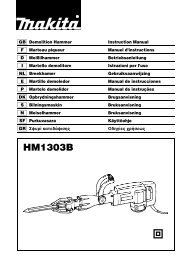SP6000 - Makita
SP6000 - Makita
SP6000 - Makita
Create successful ePaper yourself
Turn your PDF publications into a flip-book with our unique Google optimized e-Paper software.
15. Avoid Cutting Nails. Inspect for and remove all<br />
nails from lumber before cutting.<br />
16. Place the wider portion of the saw base on that<br />
part of the workpiece which is solidly supported,<br />
not on the section that will fall off when the cut is<br />
made. As examples, Fig. 5 illustrates the RIGHT<br />
way to cut off the end of a board, and Fig. 6 the<br />
WRONG way. If the workpiece is short or small,<br />
clamp it down. DO NOT TRY TO HOLD SHORT<br />
PIECES BY HAND!<br />
17. Never attempt to saw with the circular saw held<br />
upside down in a vise. This is extremely<br />
dangerous and can lead to serious accidents.<br />
(Fig. 7)<br />
18. Some material contains chemicals which may be<br />
toxic. Take caution to prevent dust inhalation and<br />
skin contact. Follow material supplier safety data.<br />
19. Do not stop the blades by lateral pressure on the<br />
saw blade.<br />
20. Always use blades recommended in this manual.<br />
Do not use any abrasive wheels.<br />
21. Wear a dust mask and hearing protection when<br />
use the tool.<br />
SAVE THESE INSTRUCTIONS.<br />
WARNING:<br />
MISUSE or failure to follow the safety rules stated in<br />
this instruction manual may cause serious personal<br />
injury.<br />
FUNCTIONAL DESCRIPTION<br />
CAUTION:<br />
• Always be sure that the tool is switched off and<br />
unplugged before adjusting or checking function on the<br />
tool.<br />
Adjusting depth of cut (Fig. 8)<br />
CAUTION:<br />
• After adjusting the depth of cut, always tighten the<br />
clamping screw securely.<br />
Loosen the clamping screw on the depth guide and move<br />
the blade lower limit stopper to the desired depth on the<br />
scale plate. At the desired depth of cut, tighten the<br />
clamping screw firmly.<br />
For cleaner, safer cuts, set cut depth so that no more than<br />
one blade tooth projects below workpiece. Using proper<br />
cut depth helps to reduce potential for dangerous<br />
KICKBACKS which can cause personal injury.<br />
NOTE:<br />
• Setting the blade lower limit stopper to the desired<br />
depth on the scale plate allows rough depth of cut.<br />
For accurate depth of cut, measure the actual<br />
protrusion of saw blade below the tool base.<br />
Quick stop button for 2 to 3 mm depth of<br />
cut when using guide rail (accessory)<br />
(Fig. 9 & 10)<br />
This tool has the quick stop button for 2 to 3 mm depth of<br />
cut on the gear housing aside the rear handle when using<br />
guide rail. This is used when avoiding splinter on the<br />
workpiece in the cut. Make a pass of the 2 to 3 mm first<br />
cut and then make another pass of usual cut.<br />
To obtain the 2 to 3 mm depth of cut, push in the stop<br />
button toward the saw blade. This is convenient for<br />
avoiding splinter on the workpiece.<br />
To release the depth of cut from this position for free depth<br />
of cut, just pull the button back.<br />
Bevel cutting (Fig. 11)<br />
Tilting to the right (Fig. 12 & 13)<br />
Turn the positive stopper so that the arrow on it points one<br />
of two positions (vertical for 22.5°, horizontal for 45°).<br />
Loosen the clamping screws in front and back. Then, tilt<br />
the tool base until it stops and secure the base with the<br />
clamping screws.<br />
To get 48° bevel angle, move the lever to 48° marking as<br />
far as it will go. Turn the positive stopper so that the arrow<br />
on it points to the horizontal position. Then, tilt the tool<br />
base until it stops and secure the base with the clamping<br />
screws.<br />
Tilting to the left (Fig. 14)<br />
The tool can be tilted to the left 1° bevel angle. To get the<br />
left 1° bevel angle, loosen the clamping screws in front<br />
and back, tilt the tool handle slightly to the right and push<br />
two bevel angle shifting levers at the same time in the<br />
direction of arrow which has a marking -1. And then tilt the<br />
tool handle to the left while pushing these two levers at<br />
the same time. Secure the base with the clamping screws.<br />
NOTE:<br />
• Returning the blade to the right angle makes the<br />
shifting lever return to 0° by itself.<br />
Sighting (Fig. 15)<br />
When using the tool without guide rail (accessory)<br />
For straight cuts, align the A position on the front of the<br />
base with your cutting line. For 45° bevel cuts, align the B<br />
position with it.<br />
When using the tool with guide rail (accessory)<br />
For both straight cuts and 45° bevel cuts, always align the<br />
A position on the front of the base with your cutting line.<br />
Switch action (Fig. 16)<br />
CAUTION:<br />
• Before plugging in the tool, always check to see that<br />
the switch trigger actuates properly and returns to the<br />
“OFF” position when released.<br />
To prevent the switch trigger from being accidentally<br />
pulled, a lock-off button is provided. To start the tool, push<br />
in the lock-off button and pull the switch trigger.<br />
Release the switch trigger to stop.<br />
9



